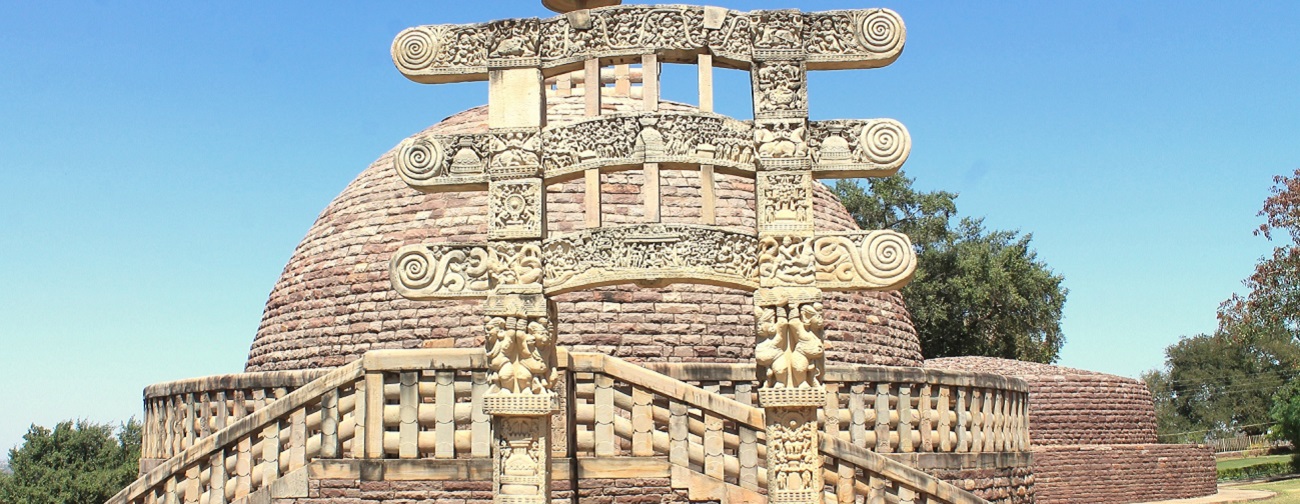Photo: Stupa 3 at Sanchi, which originally contained the relics of the Buddhist saints. Credit: Shashank Sinha
Buddhism, is one of the greatest gift of India to the other world. India’s home-grown spiritual tradition has proven to be a factor bringing in positive impacts and creating a more peaceful society. The culmination of Buddha’s search came while meditating beneath a tree, where he finally understood how to be free from suffering, and ultimately, to achieve salvation.
The core doctrine of Buddhism, known as the ‘Four Noble Truths’, teaches that one can be liberated from the suffering that underpins the cycle of death and rebirth by practising the ‘Noble Eightfold Path’. The concept of ahimsa – nonviolence was the chief contribution of Buddhism. Later, it became one of the cherished values of our nation.
Origin and Spread of Buddhism in India
Despite the fact that it is host to a relatively small population of Buddhists, India can claim legitimacy in its promotion of Buddhist diplomacy for a number of reasons.
- India – the Origin of Buddhism – the Buddhist faith originated in India, therefore granting it singular historical legitimacy. It originated in India in 563–483 B.C.E. with Siddhartha Gautama, and over the next millennia it spread across Asia and the rest of the world. A famous king, named Ashoka – the third emperor of Mauryan Dynasty and his son helped to spread Buddhism throughout South India and into Sri Lanka (Ceylon) (3rd century B.C.E.).
- Pilgrimage Sites of India – India has numerous sites of importance to the Buddhist faith, such as Bodh Gaya, Sarnath, and Nalanda. The Mahabodhi Temple in Bihar, India—the site of Buddha’s enlightenment—is now a major Buddhist pilgrimage site.
- Buddhist Architecture – Contribution of Buddhism to the architecture, sculpture and painting of India was notable. The stupas, viharas, chaityas that were built at Sanchi, Bahrut, Bodhgaya, Nalanda, Amravati, Taxila and other places are simply remarkable. Than Sanchi Stupa with its ornatmental torans is considered a masterpiece of architecture. The cave temples of Ajanta, Karle, Bhajja, Ellora etc show their achievement in rock-out cave temples. The Ajanta painting depicting touching scenes of Buddha’s life are world famous.
- Educational Promotion through Residential Universities – The Buddhist viharas were used for education purposes. Taxila, Nalanda, Vikramasila, Udyantpuri, Vallabhi and others cities developed as high Buddhist learning centres.
- Growth of Literature and Development of languages through the teachings of Buddhism – The language of Pali and other local languages developed through the teachings of Buddhism. Buddhist texts like Tripitakas, Jatakas, Buddha Charita, Mahavibhasa are assets to Indian literature.
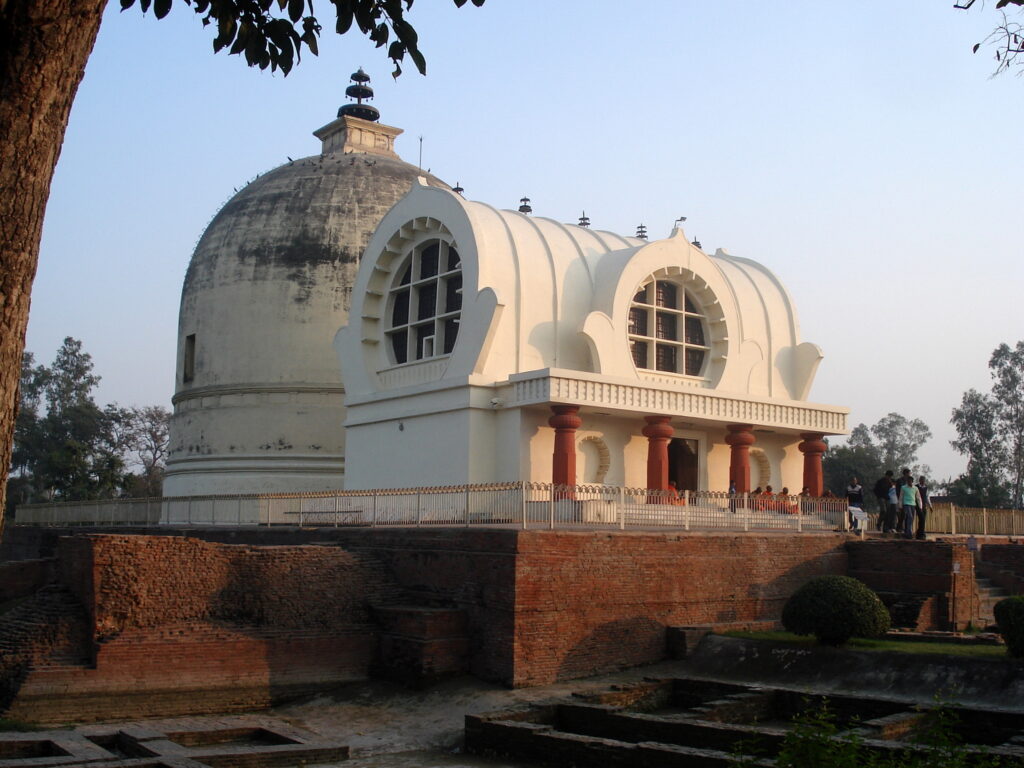
Parinivana Stupa in Kushinagar, India said to be the place of death of Gautama Buddha
Pic Courtesy: Wikipedia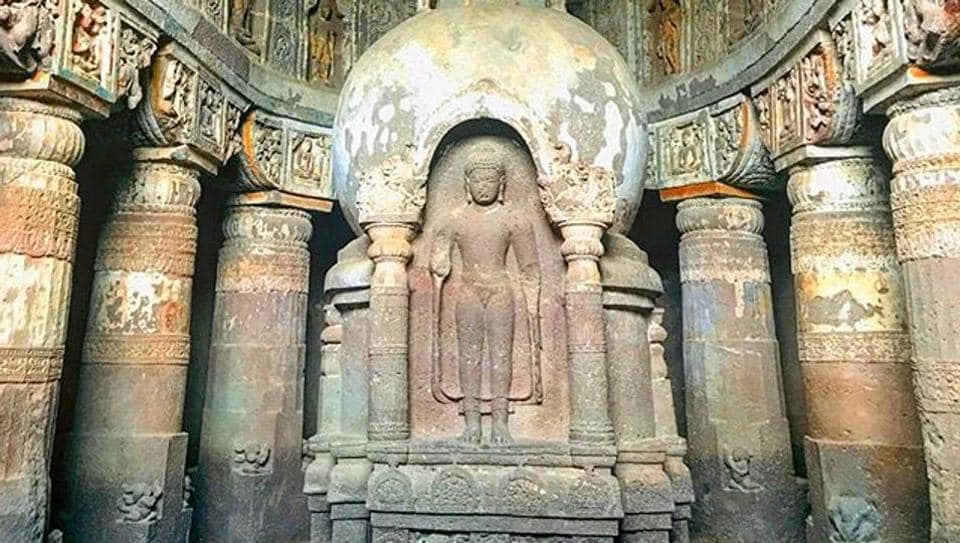
The Buddhist Caves in Ajanta – 30 rock-cut Buddhist cave monuments, Maharashtra. Pic Courtesy: Trip Sparrow/Instagram 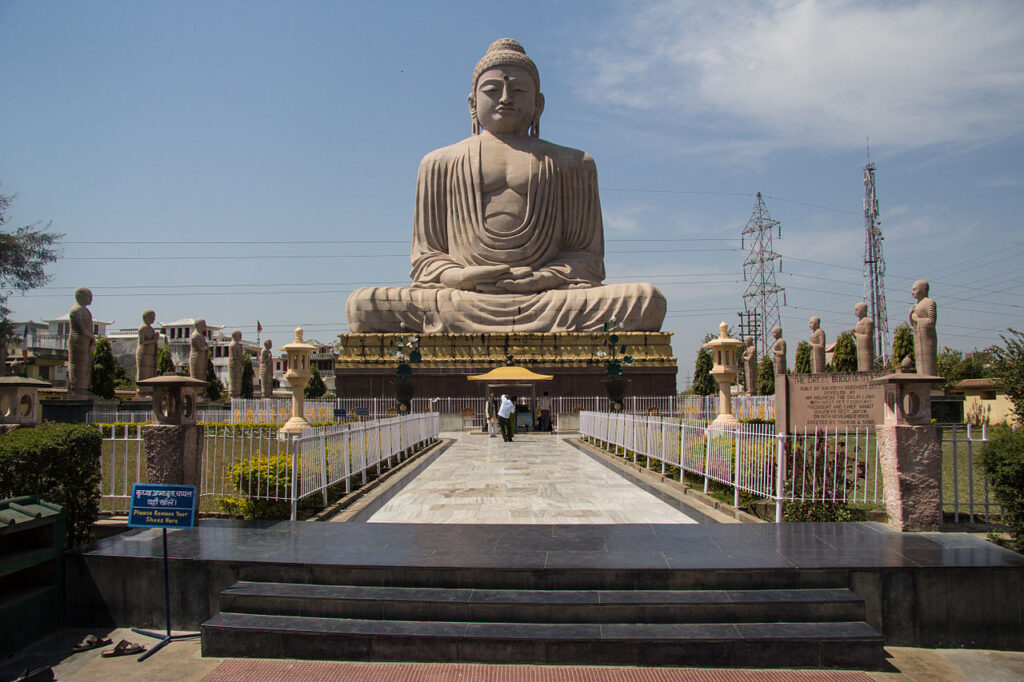
“Great Buddha Statue” at Bodh Gaya where Gautama Buddha is said to have attained enlightenment
Pic Courtesy: Wikipedia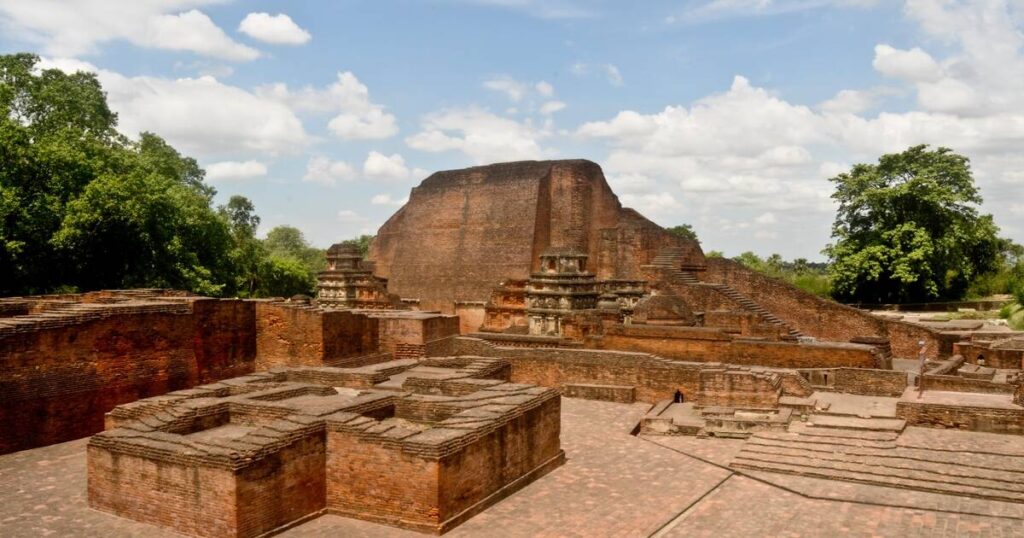
Archaeological Site of Nalanda Mahavihara, Bihar
Pic Courtesy: Rajneesh Raj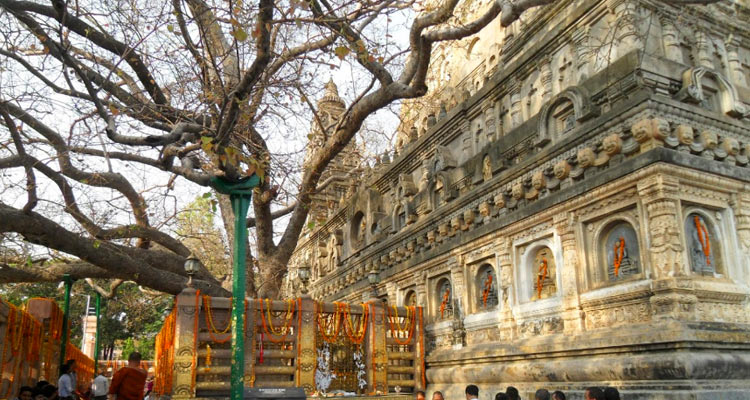
The Bodhi tree, Bodh Gaya. Pic Courtesy: Bodhgaya Tourism 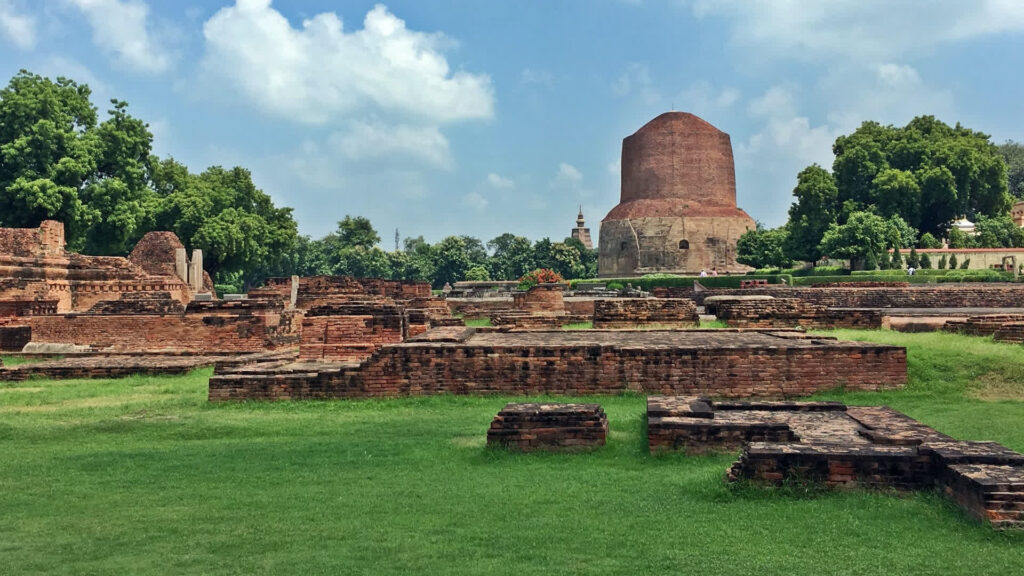
Dhamek Stupa , Sarnath– the exact spot of Buddha’s first sermon .Pic Courtesy: Live History India
Buddhist Circuit
The Buddhist Circuit is a route that follows in the footsteps of the Buddha from Lumbini in Nepal where he was born, through Bihar in India where he attained enlightenment, to Sarnath and Kushinagar in Uttar Pradesh in India, where he gave his first teachings and died. This iconic route only includes places where the Buddha actually spent time, and these sites – all of which are over 2500 years old – are among the most significant and revered for all Buddhists. The Buddhist Circuit is an important pilgrimage destination for the 450 million practicing Buddhists as well as travelers interested in history, culture or religion.
Key destinations on the Buddhist Tourism Circuit in India
Buddhism originated in India and seven of the eight main Buddhist pilgrimage sites are in India. The most important places are:
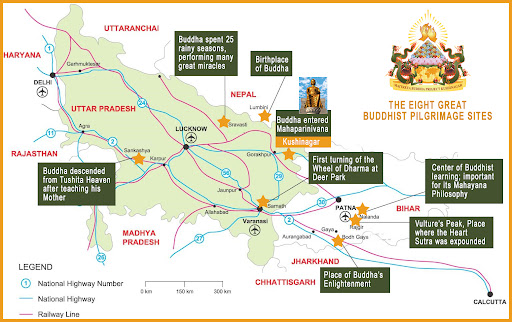
- Bodhgaya (in Bihar) – where Buddha attained enlightenment under the Bodhi Tree. Every year, hundreds of thousands of pilgrims visit the Mahabodhi temple. The site is seen by Buddhists as the birthplace of their faith. The world-famous temple is a UNESCO World Heritage Site and the present tree, about 80ft high and approximately 115 years old, is the fifth generation of the original Bodhi tree.
- Sarnath (in Uttar Pradesh) – where he delivered his first sermon, set the wheel of dharma in motion and it is also the place of birth for the Sangha (the religious followers of Buddha). Ashoka is believed to have erected the Dhameka stupa here in 249 BCE.
- Nalanda and Rajgir (in Bihar) – where he lived and taught, and Nalanda, in particular, became the center of Buddhist learning and teaching. The ruins of Nalanda stand testimony to one of the greatest centres of learning in recorded history. This once world famous university attracted students from other parts of the world during the 5th-12th centuries AD.
- Kushinagar (in Uttar Pradesh) – where the Buddha attained Mahaparinirvana (ultimate salvation) .
- Vaishali (in Bihar)– Buddha’s last sermon delivered.
- Sravasti (in Uttar Pradesh) – Buddha spent twenty four rainy seasons here at the Jetavan monastery, built by his disciple Sudatta Anathapindika.
- Kausambi (in Uttar Pradesh) – Buddha is believed to have stayed and preached at Kausambi.
Photo: The eight great pilgrimage sites are illustrated on the map above; Pic Courtesy: Maitreya Buddha Project Kushinagar

Sirpur (in Chattisgarh) which contains the remains of the ancient and medieval Buddhist era, is said to be the largest Buddhist site ever discovered in India, much larger and older than that of Nalanda, Bihar. Nagarjuna – a famous Buddhist philosopher of 150-200 A.D went to Sirpur and mediated in the caves of Sirpur. Sirpur is one of the most treasured places for Buddhists. There are eight viharas in Sirpur, which according to historians’ claims shed light on Buddhism during the latter half of first millennium A.D.. Chinese traveller Hiuen Tsang visited Sirpur in 639 A.D. and vividly described the town and its predominantly Buddhist rituals. Among the numerous temples and Buddhist monasteries (viharas) one of the most notable is the recently excavated Tivaradeva MahaviharaL adn akshman Temple (one of the finest brick temples).
Photo: 8th century Buddha statue at Tivara Deva Vihara, Sirpur monuments; Pic Courtesy: Wikimedia Commons
Recently Indian Railway Catering and Tourism Corporation Limited launched the Buddhist Circuit Tourist Train – a special tourist train which runs the Buddhist Circuit and covers all prominent locations linked to the life of Gautama Buddha. For more details check out the official site of Buddhist Circuit Tourist Train HERE.
Source:
1. India: the origin of Buddhism by National Council of Science Museums, Kolkata, Retrieved from https://indianculture.gov.in/ebooks/india-origin-buddhism
2. Investing in The Buddhist Circuit by IFC, Retrieved from https://www.ifc.org/wps/wcm/connect/2bdd4697-6d7f-4f78-bca0-269aa100b25a/Buddhist+Circuit+Tourism+Strategy+Final.pdf?MOD=AJPERES&CVID=kC1uny1


